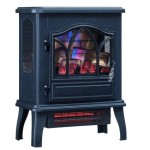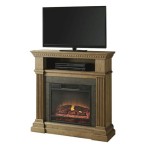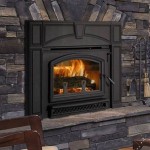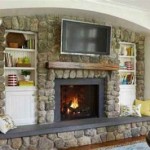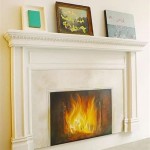Ventless Gel Fireplaces: Weighing the Pros and Cons
Ventless gel fireplaces have gained popularity as an alternative to traditional wood-burning or gas fireplaces. They offer a convenient and aesthetically pleasing way to introduce the ambiance of a fire into a space without the complexities of venting systems. However, like any heating or decorative appliance, ventless gel fireplaces come with their own set of advantages and disadvantages. Understanding these aspects is crucial for making an informed decision about whether a ventless gel fireplace suits individual needs and preferences.
Ventless gel fireplaces operate by burning a gel fuel, typically composed of isopropyl alcohol and other ingredients. This fuel is contained in canisters or cartridges placed within the fireplace unit. Upon ignition, the gel produces a flame that mimics the appearance of a traditional fire. The absence of a chimney or vent allows for greater flexibility in placement, as the fireplace is not restricted by existing ductwork or structural constraints.
Advantages of Ventless Gel Fireplaces
One of the most significant advantages of ventless gel fireplaces is their ease of installation and portability. Unlike traditional fireplaces, they do not require costly and invasive installations such as chimneys, gas lines, or electrical wiring. This makes them an appealing option for apartments, condominiums, or homes where installing a conventional fireplace is impractical or prohibited. The compact and lightweight design of many models allows for easy relocation, enabling users to move the fireplace from room to room or even take it with them when moving residences.
The aesthetic appeal of ventless gel fireplaces is another key benefit. They offer a realistic-looking flame that creates a warm and inviting atmosphere. Many models incorporate decorative elements such as faux logs, stones, or glass beads, enhancing the visual appeal and mimicking the appearance of a traditional wood-burning fireplace. This aesthetic flexibility allows homeowners to customize the fireplace to match their existing décor and create a desired ambiance, whether it be rustic, modern, or contemporary.
Convenience is a major selling point for ventless gel fireplaces. They are easy to operate, requiring only the placement of a gel fuel canister and ignition with a lighter or match. The flame is easily extinguished by simply cutting off the oxygen supply, typically done by placing a metal snuffer over the opening of the fuel canister. Maintenance is minimal, as there is no need for chimney cleaning or ash removal. This makes them a low-maintenance option for those seeking the ambiance of a fire without the associated upkeep.
From an environmental perspective, ventless gel fireplaces offer a relatively clean-burning alternative to wood-burning fireplaces. They produce minimal smoke, soot, or ash, reducing the impact on indoor air quality and the environment. While they do release carbon dioxide during combustion, the amount is generally considered to be less than that produced by traditional wood-burning fireplaces. However, proper ventilation is still crucial, as with any combustion appliance.
Disadvantages of Ventless Gel Fireplaces
Despite their advantages, ventless gel fireplaces also have significant drawbacks that need to be considered. One of the most prominent concerns is their limited heating capacity. Gel fireplaces are primarily designed for aesthetic purposes and are not intended to be a primary source of heat. They typically produce a relatively small amount of heat, which may be sufficient to warm a small room or area but is unlikely to provide significant heating for larger spaces. Relying on a gel fireplace as a primary heat source can be inefficient and costly, as the cost of gel fuel can quickly add up.
Safety is another critical consideration. While ventless gel fireplaces are generally safe when used according to manufacturer instructions, they do pose certain risks. The open flame can be a fire hazard if flammable materials are placed too close to the fireplace. It is essential to maintain a safe distance between the fireplace and curtains, furniture, or other combustible items. Improper handling of gel fuel can also lead to spills or fires. It is imperative to store gel fuel in a safe location away from heat sources and to follow all safety precautions outlined in the product manual.
Air quality is a persistent concern with ventless gel fireplaces. Although they produce less smoke than wood-burning fireplaces, they still release pollutants into the air, including carbon dioxide, carbon monoxide, and volatile organic compounds (VOCs). These pollutants can potentially affect indoor air quality, particularly in poorly ventilated spaces. Carbon monoxide is a colorless, odorless gas that can be deadly at high concentrations. While ventless gel fireplaces are designed to minimize carbon monoxide emissions, it is still essential to ensure adequate ventilation to prevent the build-up of this harmful gas. Regular monitoring with a carbon monoxide detector is recommended.
The cost of gel fuel is another factor to consider. Gel fuel is a consumable item that needs to be replenished regularly, depending on the frequency of use. The cost of gel fuel can vary depending on the brand, quantity purchased, and retailer. Over time, the cost of fuel can exceed the initial cost of the fireplace itself, making it a relatively expensive option compared to other heating alternatives. It is essential to factor in the ongoing fuel costs when evaluating the overall cost-effectiveness of a ventless gel fireplace. Additionally, some brands of gel fuel may contain additives or chemicals that can produce unpleasant odors or release harmful substances during combustion.
Key Safety Considerations
To mitigate the risks associated with ventless gel fireplaces, it is crucial to adhere to strict safety precautions. Always follow the manufacturer's instructions for installation, operation, and maintenance. Ensure that the fireplace is placed on a stable, non-flammable surface and is kept away from flammable materials. Never leave a burning fireplace unattended and keep children and pets away from the flames. Use only gel fuel that is specifically designed for use in ventless gel fireplaces and avoid using alternative fuels or homemade solutions, as these can be dangerous.
Proper ventilation is essential when using a ventless gel fireplace. Open windows or doors to allow for fresh air circulation and prevent the build-up of pollutants. Install a carbon monoxide detector in the vicinity of the fireplace to monitor carbon monoxide levels and provide an early warning in case of a leak. Regularly inspect the fireplace for any signs of damage or malfunction and address any issues promptly. If you experience any symptoms of carbon monoxide poisoning, such as headache, dizziness, nausea, or shortness of breath, immediately turn off the fireplace, ventilate the area, and seek medical attention.
In conclusion, ventless gel fireplaces offer a convenient and aesthetically pleasing way to enjoy the ambiance of a fire without the complexities of traditional fireplaces. Their ease of installation, portability, and aesthetic appeal make them an attractive option for many homeowners. However, it is crucial to be aware of their limitations, including their limited heating capacity, potential safety hazards, and air quality concerns. By carefully weighing the pros and cons and adhering to strict safety precautions, individuals can make an informed decision about whether a ventless gel fireplace is the right choice for their needs.
Furthermore, consider local regulations and building codes. Some areas may have restrictions on the use of ventless fireplaces, particularly in apartments or multi-family dwellings. Check with local authorities or building inspectors to ensure compliance with all applicable regulations before purchasing and installing a ventless gel fireplace. This proactive step can prevent potential legal issues or safety hazards down the line.
Choosing a reliable supplier for both the fireplace and the gel fuel is also paramount. Opt for reputable brands that have a proven track record of safety and quality. Reading reviews and gathering feedback from other users can provide valuable insights into the performance and reliability of different models and fuel types. Avoid purchasing products from unverified sources or manufacturers, as these may not meet safety standards and could pose a greater risk.
Finally, remember that ventless gel fireplaces are not a replacement for a properly installed and maintained heating system. They should be considered as a supplementary source of heat and ambiance, rather than a primary heating solution. If you are looking for a reliable and efficient way to heat your home, consider alternative options such as central heating systems, electric heaters, or gas fireplaces with proper venting.

Ventless Gas Fireplace Propane

Ventless Fireplaces What You Need To Know

Ventless Fireplaces What You Need To Know

Ventless Gas Fireplaces What You Need To Know Roofing Contractor Chimney Sweep Siding Masonry New Jersey

Duluth Forge Dual Fuel Ventless Fireplace 32 000 Btu Remote Control Chocolate Finish 170158 The Home Depot

Ventless Fireplaces What You Need To Know

Comparing Types Of Fireplaces Hearth Cabinet

Artificial Fireplaces Gel Vs Electric Gas Log 2024 Today S Homeowner

Ventless Gas Fireplaces Complete Guide Modern Blaze

Duluth Forge Dual Fuel Ventless Gas Fireplace 26 000 Btu T Stat Control Apple Spice Finish 170153 The Home Depot
Related Posts


